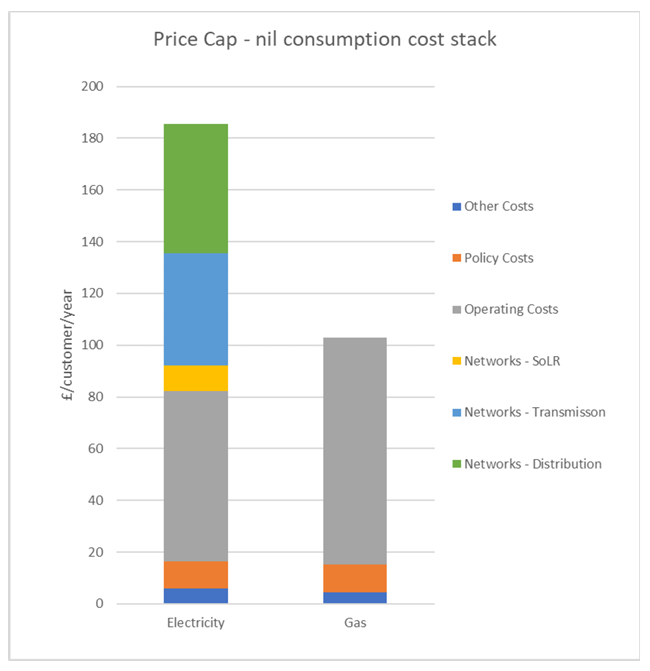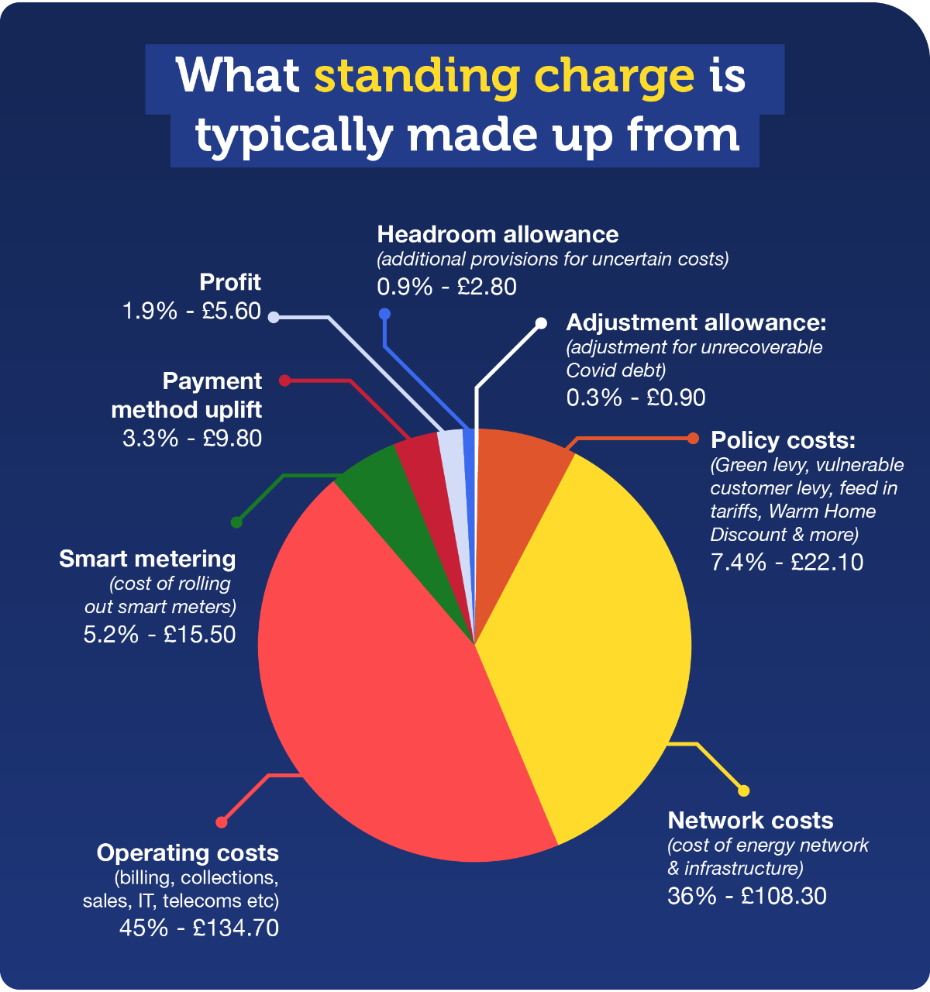We’d like to remind Forumites to please avoid political debate on the Forum.
This is to keep it a safe and useful space for MoneySaving discussions. Threads that are – or become – political in nature may be removed in line with the Forum’s rules. Thank you for your understanding.
📨 Have you signed up to the Forum's new Email Digest yet? Get a selection of trending threads sent straight to your inbox daily, weekly or monthly!
Zero standing charge tariff proposal
Comments
-
I've never seen it suggested that everyone would have to choose a zero S/C tariff. But if one is offered then you're quite correct, it will need to be subsidised from somewhere.michaels said:
Moving cost to the electricity tariff from the SC so that higher users (like my daughter who rents an all electric non Economy 7 single glazed flat) get to subsidise the network and supplier costs of lower users0 -
I too would like the source for that first sentence, please!michaels said:You do know a big chunk of the SC is part of the benefits system, a direct transfer from the majority of consumers to those the govt deems worthy of subsidy. Some would argue that benefits should come from taxation and be clearly reported as such but not surprisingly it suits govts of all colours to move benefits out of the national tax and spend figures
Moving cost to the electricity tariff from the SC so that higher users (like my daughter who rents an all electric non Economy 7 single glazed flat) get to subsidise the network and supplier costs of lower users like second home owners and those who have had the 500k needed to build an eco home - does anyone claim it is less costly to set up an account and do the billing and maintain the wires and pipes for someone who uses £50 per month compared to someone who uses £200?
Finally of course it sounds like very bad news for anyone who has or is contemplating a heat pump....
As to the second paragraph - why in earth would your daughter move to the zero SC tariff if it was going to cost her more? I take it she is currently on a tariff like the specialist Octopus Snug which is designed for storage heater users - which I assume she is? She just needs to stay out. Just because the zero SC tariffs will be offered doesn’t mean everyone should jump to them - it’s a bit like Economy 7 tariffs currently, they exist, most folk could get them, but also most folk would pay a bit more on them, so stay on single rate!Third paragraph - again, it’s not as those people simply won opt for that tariff. Again, there are specialist heat pump friendly tariffs available which are likely best for most folk with heat pumps.Remember, thanks to smart metering, energy is no longer a “one size fits all” approach - there are more tariffs out there designed to suit quite specific user profiles now than you can shake a stick at!🎉 MORTGAGE FREE (First time!) 30/09/2016 🎉 And now we go again…New mortgage taken 01/09/23 🏡
Balance as at 01/09/23 = £115,000.00 Balance as at 31/12/23 = £112,000.00
Balance as at 31/08/24 = £105,400.00 Balance as at 31/12/24 = £102,500.00
Balance as at 31/08/25 = £ 95,450.00
£100k barrier broken 1/4/25SOA CALCULATOR (for DFW newbies): SOA Calculatorshe/her0 -
For certain values of 'big', perhaps. Costs resulting from Government policy are lumped together as ... errr ... 'Policy costs'. In the current quarter, all of the policy costs amount to less than 11% of the price cap. They are:michaels said:You do know a big chunk of the SC is part of the benefits system, a direct transfer from the majority of consumers to those the govt deems worthy of subsidy.
Energy Company Obligation (ECO)Great British Insulation Scheme (GBIS)Warm Home Discount (WHD)Renewables Obligation (RO)Feed-in Tariffs scheme (FIT)Offtaker of Last Resort (OLR)Fuel Mix Disclosure (FMD)Smart Export Guarantee (SEG)Green Gas Levy (GGL)
Yes, some of those involve robbing the rich to pay the poor, like ECO4 and GBIS helping improve the energy efficiency of housing. Some of them work the other way, like FIT and SEG which reward those affluent enough to be able to generate power to return to the grid. The only one which could arguably be classed as part of the benefits system is the Warm Home Discount.
There's a wealth of detail about what goes into the price cap at Ofgem's site, including this chart (p. 21 here) which illustrates what makes up the Standing Charge:

See also Supplier obligations: environmental and social schemes | Ofgem for more detail.I'm not being lazy ...
I'm just in energy-saving mode.3 -
However, you'd have to wonder why gas doesn't have any network transmission or distribution costs. I guess that they still have to provide piping, metering, storage, possibly pumping etc and any other costs involved in getting gas from whence it comes to the meter in your house.
It may not be quite the same as leccy but I'd suggest that it isn't zero as the above chart suggests, unless us leccy users are subsidising that as well.
I would also think that if the aim was to wean people off fossil fuels and onto greener fuels then loading all the cost onto leccy rather than sharing some of it onto gas isn't the best way to encourage people to change - just my opinion you understand.Never under estimate the power of stupid people in large numbers0 -
Why that's not in their interests at all.WibbleBaaaaaa said:It would be great if supplers could offer at least 1 cheap solar panel that can be placed anywhere, roofs, balconies, windows, to every customer that would generate enough lekky to pay for the daily standing charge automatically.
And we would just pay for it in our bills.
Now you might argue the govt could. But then why wouldn't that need to be means tested.
0 -
Can I throw in a spanner? I have SM2 for both Elec and Gas. Both rely on O2 and the signal does not get through so my meters are 'dumb'. I lose out massively! Not able to take advantage of the best tarrifs through a tech fail.
I feel disenfranchised. Basically I should not have to contribute to any enhancement for SMs as I cannot take advantage of them - and hence not the standing charge.0 -
A chunk but hardly a massive chunk.Qyburn said:
Do you have a source for that? I wasn't able to find breakdown in that detail.michaels said:You do know a big chunk of the SC is part of the benefits system, a direct transfer from the majority of consumers to those the govt deems worthy of subsidy.
There's a 4 way breakdown of the electric sc in the Ofgem Aug consultation report.
https://consult.ofgem.gov.uk/energy-supply/standing-charges-domestic-retail-options/supporting_documents/standing_charges_domestic_retail_options.pdf
Of tge £220 electric SC £121 - 55% is network costs.
Other components include suppliers operating costs (billing staff etc ) at £62.
Other costs - vat and ebit nd headroom on those costs adding £26. Some of the debt special maybe ?
Policy costs - where social cross subsidy like GBIS occur for both gas and electric only contribute £11 to each.
So £11/220 = 5% electric
£11/ 115 = 9% gas.
And as per ldhund's post above that £22 contains many components.
Although perhaps operating costs include significant costs / component dealing with debt and arrears so not that clear cut.0 -
there is this https://blog.moneysavingexpert.com/2023/07/martin-lewis--why-are-energy-standing-charges-so-high--what-can-/Qyburn said:
Do you have a source for that? I wasn't able to find breakdown in that detail.michaels said:You do know a big chunk of the SC is part of the benefits system, a direct transfer from the majority of consumers to those the govt deems worthy of subsidy.
Looks like the "big chunk" is part of the 7.4% and the "benefit system" is only a segment of that.
Let's Be Careful Out There4 -
This is all over Social Media & people saying great idea, as they have no concept of what the SC is for & think the suppliers are making massive profits. All the usual miss truths.
They are forgetting the thought involved in doing their costings to see if it's cost effective to them.
So Cue the next big energy rip off & complaints. We switched to zero SC & ended up worse off...🤦♀️🤣Life in the slow lane4 -
FWIW I think there is a good case for giving people who have smart meters but aren't able to benefit from TOU tariffs because of communication issues either a reduced SC or access to some kind of preferential tariff.MarzipanCrumble said:Can I throw in a spanner? I have SM2 for both Elec and Gas. Both rely on O2 and the signal does not get through so my meters are 'dumb'. I lose out massively! Not able to take advantage of the best tarrifs through a tech fail.
I feel disenfranchised. Basically I should not have to contribute to any enhancement for SMs as I cannot take advantage of them - and hence not the standing charge.0
Confirm your email address to Create Threads and Reply

Categories
- All Categories
- 352.8K Banking & Borrowing
- 253.8K Reduce Debt & Boost Income
- 454.6K Spending & Discounts
- 245.8K Work, Benefits & Business
- 601.9K Mortgages, Homes & Bills
- 177.7K Life & Family
- 259.7K Travel & Transport
- 1.5M Hobbies & Leisure
- 16K Discuss & Feedback
- 37.7K Read-Only Boards










